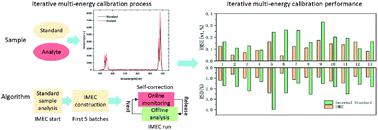当前位置:
X-MOL 学术
›
J. Anal. At. Spectrom.
›
论文详情
Our official English website, www.x-mol.net, welcomes your
feedback! (Note: you will need to create a separate account there.)
Iterative multi-energy calibration and its application in online alloy smelting process monitoring using laser-induced breakdown spectroscopy
Journal of Analytical Atomic Spectrometry ( IF 3.1 ) Pub Date : 2020-07-08 , DOI: 10.1039/d0ja00247j Xin Li 1, 2, 3, 4, 5 , Tianzhuo Zhao 1, 2, 3, 4, 5 , Qixiu Zhong 1, 2, 3, 4, 5 , Shuzhen Nie 1, 2, 3, 4, 6 , Hong Xiao 1, 2, 3, 4, 6 , Shenghai Zhao 1, 2, 3, 4, 6 , Wendi Huang 1, 2, 3, 4, 5 , Zhongwei Fan 1, 2, 3, 4, 5
Journal of Analytical Atomic Spectrometry ( IF 3.1 ) Pub Date : 2020-07-08 , DOI: 10.1039/d0ja00247j Xin Li 1, 2, 3, 4, 5 , Tianzhuo Zhao 1, 2, 3, 4, 5 , Qixiu Zhong 1, 2, 3, 4, 5 , Shuzhen Nie 1, 2, 3, 4, 6 , Hong Xiao 1, 2, 3, 4, 6 , Shenghai Zhao 1, 2, 3, 4, 6 , Wendi Huang 1, 2, 3, 4, 5 , Zhongwei Fan 1, 2, 3, 4, 5
Affiliation

|
This report proposes an iterative multi-energy calibration (IMEC) method for online alloy smelting process monitoring and describes its performance verification on online laser-induced breakdown spectroscopy (LIBS) monitoring equipment in application factories. The proposed IMEC method is an improvement upon the existing MEC method; it involves two stages: standard sample preparation and implementation of a quantitative analysis algorithm. Compared with the internal standard (IS) method, the average root mean square error (RMSE) and relative standard deviation are improved from 0.19 wt% to 0.11 wt% and from 2.2% to 1.1%, respectively. To evaluate the IMEC performance more scientifically, a ‘bootstrapping’ method was employed, in which 10 000 sets of data sequences were reconstructed from real data and inputs for IMEC. With this statistics-based approach, the average RMSEs for the IMEC and IS methods were found to be 0.084 wt% and 0.185 wt%, respectively. Furthermore, the IMEC convergence graph indicated that the prediction RMSE quickly decreases to approximately 0.080 wt% and stabilises within 40 iterations. The proposed IMEC method has important potential applications in industrial-grade LIBS online quantitative analysis.
中文翻译:

迭代多能校准及其在激光诱导击穿光谱在线监测合金熔炼过程中的应用
本报告提出了一种在线合金熔炼过程监控的迭代多能量校准(IMEC)方法,并描述了其在应用工厂中的在线激光诱导击穿光谱(LIBS)监控设备上的性能验证。提出的IMEC方法是对现有MEC方法的改进。它包括两个阶段:标准样品的制备和定量分析算法的实施。与内标(IS)方法相比,平均均方根误差(RMSE)和相对标准偏差分别从0.19 wt%提高到0.11 wt%和从2.2%提高到1.1%。为了更科学地评估IMEC的性能,采用了一种“自举”方法,其中从真实数据和IMEC的输入中重建了10000套数据序列。使用这种基于统计的方法,发现IMEC和IS方法的平均RMSE分别为0.084 wt%和0.185 wt%。此外,IMEC收敛图表明,预测的RMSE迅速降低至约0.080 wt%,并在40次迭代中稳定下来。提出的IMEC方法在工业级LIBS在线定量分析中具有重要的潜在应用。
更新日期:2020-07-08
中文翻译:

迭代多能校准及其在激光诱导击穿光谱在线监测合金熔炼过程中的应用
本报告提出了一种在线合金熔炼过程监控的迭代多能量校准(IMEC)方法,并描述了其在应用工厂中的在线激光诱导击穿光谱(LIBS)监控设备上的性能验证。提出的IMEC方法是对现有MEC方法的改进。它包括两个阶段:标准样品的制备和定量分析算法的实施。与内标(IS)方法相比,平均均方根误差(RMSE)和相对标准偏差分别从0.19 wt%提高到0.11 wt%和从2.2%提高到1.1%。为了更科学地评估IMEC的性能,采用了一种“自举”方法,其中从真实数据和IMEC的输入中重建了10000套数据序列。使用这种基于统计的方法,发现IMEC和IS方法的平均RMSE分别为0.084 wt%和0.185 wt%。此外,IMEC收敛图表明,预测的RMSE迅速降低至约0.080 wt%,并在40次迭代中稳定下来。提出的IMEC方法在工业级LIBS在线定量分析中具有重要的潜在应用。










































 京公网安备 11010802027423号
京公网安备 11010802027423号